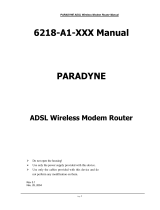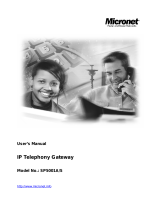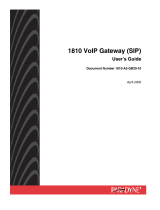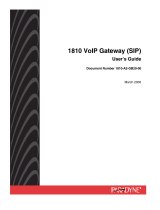
1813 VoIP Gateway
User’s Guide
Document Number 1813-A2-GB20-00
November 2004

1813 VoIP Gateway User’s Guide
Copyright © 2004 Paradyne Corporation.
All rights reserved.
Printed in U.S.A.
Notice
This publication is protected by federal copyright law. No part of this publication may be copied or distributed,
transmitted, transcribed, stored in a retrieval system, or translated into any human or computer language in any form
or by any means, electronic, mechanical, magnetic, manual or otherwise, or disclosed to third parties without the
express written permission of Paradyne Corporation, 8545 126th Ave. N., Largo, FL 33773.
Paradyne Corporation makes no representation or warranties with respect to the contents hereof and specifically
disclaims any implied warranties of merchantability or fitness for a particular purpose. Further, Paradyne Corporation
reserves the right to revise this publication and to make changes from time to time in the contents hereof without
obligation of Paradyne Corporation to notify any person of such revision or changes.
Changes and enhancements to the product and to the information herein will be documented and issued as a new
release to this manual.
Warranty, Sales, Service, and Training Information
Contact your local sales representative, service representative, or distributor directly for any help needed. For
additional information concerning warranty, sales, service, repair, installation, documentation, training, distributor
locations, or Paradyne worldwide office locations, use one of the following methods:
Internet: Visit the Paradyne World Wide Web site at www.paradyne.com. (Be sure to register your warranty at
www.paradyne.com/warranty.)
Telephone: Call our automated system to receive current information by fax or to speak with a company
representative.
Within the U.S.A., call 1-800-870-2221
Outside the U.S.A., call 1-727-530-2340
Document Feedback
We welcome your comments and suggestions about this document. Please mail them to Technical Publications,
Paradyne Corporation, 8545 126th Ave. N., Largo, FL 33773, or send e-mail to [email protected]. Include
the number and title of this document in your correspondence. Please include your name and phone number if you
are willing to provide additional clarification.
Trademarks
Acculink, Bitstorm, Comsphere, DSL the Easy Way, ETC, Etherloop, FrameSaver, GranDSLAM, GrandVIEW,
Hotwire, the Hotwire logo, Jetstream, MVL, NextEDGE, Net to Net Technologies, OpenLane, Paradyne, the
Paradyne logo, Paradyne Credit Corp., the Paradyne Credit Corp. logo, Performance Wizard, StormPort, TruePut are
registered trademarks of Paradyne Corporation. ADSL/R, Connect to Success, Hotwire Connected, iMarc, JetFusion,
JetVision, MicroBurst, PacketSurfer, Quick Channel, ReachDSL, Reverse Gateway, Spectrum Manager, and
StormTracker are trademarks of Paradyne Corporation. All other products and services mentioned herein are the
trademarks, service marks, registered trademarks, or registered service marks of their respective owners.
CE Marking
When the product is marked with the CE mark on the equipment label, a supporting Declaration of Conformity may be
downloaded from the Paradyne World Wide Web site at www.paradyne.com. Select Library → Technical Manuals
→ CE Declarations of Conformity.
2

1813 VoIP Gateway User’s Guide
Preface
This manual is written to provide information to network administrators. It covers the
installation, operation and applications of the 1813 VoIP Gateway.
Important Safety Instructions
1. Read and follow all warning notices and instructions marked on the product or included in
the manual.
2. Slots and openings in the cabinet are provided for ventilation. To ensure reliable operation of
the product and to protect it from overheating, these slots and openings must not be blocked
or covered.
3. Do not allow anything to rest on the power cord and do not locate the product where persons
will walk on the power cord.
4. Do not attempt to service this product yourself, as opening or removing covers may expose
you to dangerous high voltage points or other risks. Refer all servicing to qualified service
personnel.
5. When installed in the final configuration, the product must comply with the applicable Safety
Standards and regulatory requirements of the country in which it is installed. If necessary,
consult with the appropriate regulatory agencies and inspection authorities to ensure
compliance.
6. A rare phenomenon can create a voltage potential between the earth grounds of two or more
buildings. If products installed in separate buildings are interconnected, the voltage potential
may cause a hazardous condition. Consult a qualified electrical consultant to determine
whether or not this phenomenon exists and, if necessary, implement corrective action prior to
interconnecting the products.
7. Input power to this product must be provided by one of the following: (1) a UL Listed/CSA
certified power source with a Class 2 or Limited Power Source (LPS) output for use in North
America, or (2) a certified transformer, with a Safety Extra Low Voltage (SELV) output
having a maximum of 240 VA available, for use in the country of installation.
8. In addition, since the equipment is to be used with telecommunications circuits, take the
following precautions:
— Never install telephone wiring during a lightning storm.
— Never install telephone jacks in wet locations unless the jack is specifically designed for wet
locations.
— Never touch uninsulated telephone wires or terminals unless the telephone line has been
disconnected at the network interface.
— Use caution when installing or modifying telephone lines.
3

1813 VoIP Gateway User’s Guide
— Avoid using a telephone (other than a cordless type) during an electrical storm. There may be
a remote risk of electric shock from lightning.
— Do not use the telephone to report a gas leak in the vicinity of the leak.
CE Marking
When the product is marked with the CE mark on the equipment label, a supporting Declaration
of Conformity may be downloaded from the Paradyne World Wide Web site at
www.paradyne.com. Select Support -> Technical Manuals -> Declarations of Conformity.
FCC Part 15 Declaration
An FCC Declaration of Conformity may be downloaded from the Paradyne World Wide Web
site at www.paradyne.com. Select Support -> Technical Manuals -> Declarations of
Conformity.
This device complies with Part 15 of the FCC Rules. Operation is subject to the following two
conditions: (1) this device may not cause harmful interference, and (2) this device must accept
any interference received, including interference that may cause undesired operation.
The authority to operate this equipment is conditioned by the requirement that no modifications
will be made to the equipment unless the changes or modifications are expressly approved by the
responsible party.
This equipment has been tested and found to comply with the limits for a Class B digital device,
pursuant to Part 15 of the FCC Rules. These limits are designed to provide reasonable protection
against harmful interference in a residential installation. This equipment generates, uses, and can
radiate radio frequency energy and, if not installed and used in accordance with the instructions,
may cause harmful interference to radio communications. However, there is no guarantee that
interference will not occur in a particular installation. If this equipment does cause harmful
interference to radio or television reception, which can be determined by turning the equipment
off and on, the user is encouraged to try to correct the interference by one or more of the
following measures:
• Reorient or relocate the receiving antenna.
• Increase the separation between the equipment and receiver.
• Connect the equipment into an outlet on a circuit different from that to which the receiver is
connected.
• Consult the dealer or an experienced radio/TV technician for help.
4

1813 VoIP Gateway User’s Guide
Table of Contents
CHAPTER 1 INTRODUCTION...........................................................................................................................7
1.1 PRODUCT OVERVIEW .......................................................................................................................................7
1.2 FEATURES.........................................................................................................................................................7
1.3 APPLICATIONS..................................................................................................................................................8
CHAPTER 2 HARDWARE INSTALLATION....................................................................................................9
2.1 RESET BUTTON ................................................................................................................................................9
2.2 WIRING INSTALLATION...................................................................................................................................10
2.3 FRONT PANEL LED INDICATORS ....................................................................................................................11
CHAPTER 3 LOGIN VIA THE WEB BROWSER ..........................................................................................12
3.1 IP ADDRESS ...................................................................................................................................................12
3.2 VERSION ........................................................................................................................................................13
3.3 LOGIN PROCEDURE ........................................................................................................................................14
CHAPTER 4 BASIC CONFIGURATION.........................................................................................................15
4.1 ACCESS CONTROL..........................................................................................................................................15
4.2 WAN SETUP ..................................................................................................................................................17
4.3 LAN IP ADDRESS ..........................................................................................................................................20
4.4 SAV E ..............................................................................................................................................................22
4.5 ERASE ............................................................................................................................................................22
4.6 REBOOT .........................................................................................................................................................23
CHAPTER 5 SIP CONFIGURATION...............................................................................................................23
5.1 INTRODUCTION ..............................................................................................................................................24
5.2 LOCAL............................................................................................................................................................25
5.3 PHONELIST ....................................................................................................................................................27
5.4 REMOTE .........................................................................................................................................................29
5.5 CALLFORWARD..............................................................................................................................................31
CHAPTER 6 PERFORMANCE MONITORING.............................................................................................32
6.1 SYSTEM STATISTICS .......................................................................................................................................32
CHAPTER 7 SOFTWARE UPGRADE VIA FTP.............................................................................................36
APPENDIX A: SPECIFICATIONS.........................................................................................................................38
APPENDIX B: PIN ASSIGNMENTS......................................................................................................................40
APPENDIX C: TROUBLESHOOTING .................................................................................................................41
APPENDIX D: GLOSSARY.....................................................................................................................................42
5

1813 VoIP Gateway User’s Guide
6

1813 VoIP Gateway User’s Guide
Chapter 1 Introduction
This chapter introduces the 1813 VoIP Gateway. It includes a product overview, a description of
the product’s features and applications, and an explanation of the front panel LED indictors.
1.1 Product Overview
Paradyne’s 1813 is a powerful VoIP Gateway, providing predictable, real-time, toll-quality voice
over the Internet. The 1813 VoIP Gateway is designed for residential and business users. It
connects to an external Cable or DSL modem to access your broadband service.
An ordinary telephone connects to the RJ11 port (telephone jack) on the back of the 1813 VoIP
Gateway, allowing calls to be routed to anywhere in the world— significantly reducing or
eliminating long distance charges. Your PCs connected to the 1813 VoIP Gateway do not have to
be turned on for you to make calls. The 1813 VoIP Gateway solves all of your network and
telephony needs in one integrated unit, which reduces the space requirements and cost of
hardware and cabling. This makes the 1813 VoIP Gateway the most cost effective solution for
your application.
1.2 Features
Supports Voice over IP (VoIP) using SIP (Session Initiation Protocol, RFC 3261)
Uses an ordinary telephone to make Internet calls with low cost
Use just one IP address to access the Internet over your entire network
Supports Caller ID
Supports silence suppression
Configurable through your networked PC’s web browser
Remote administration and remote firmware upgrades over the Internet
Supports PPTP, L2TP, and IpSec pass-through
Internal 4-Port switch dramatically speeds up your gaming and multimedia connections
04-17595
7

1813 VoIP Gateway User’s Guide
1.3 Applications
8

1813 VoIP Gateway User’s Guide
Chapter 2 Hardware Installation
2.1 Reset Button
The figure below illustrates the back panel of the Gateway. On the left side of the rear panel
there is a reset button. This button is used to reload the factory default settings. Use a small
object like a ballpoint pen to press the button and hold it down for over three seconds. The
Gateway will be reset and all parameters will return to their factory default settings. You can
verify this process by monitoring the PHONE LED. It will turn off and then on again as the
Gateway restarts.
LAN
P
OWER
W
AN
PHONE
3X
2
X
1
X
04-17596
9

1813 VoIP Gateway User’s Guide
2.2 Wiring Installation
The next figure illustrates the wiring connections for the Gateway.
LAN
ADSL Router Modem
Network
Card
Port
Power Cable
04-17594
POWER
WAN
PHONE
3X
2X
1X
Internet
Ethernet
Cable
(RJ45)
Telephone Cable
(RJ11)
Telephone
PC
ADSL LAN Port
Note: If you have an installed DSL connection, disconnect the RJ45 cable from the back of your
computer and connect it to the WAN port of the 1813 VoIP Gateway.
1. Connect the power adapter to the POWER jack of the Gateway, then plug the power adapter
into an AC wall outlet.
2. Connect the WAN port of the Gateway to your DSL or cable modem’s LAN port with an
RJ45 connector cable.
3. Connect the LAN ports (1X- 3X) of the Gateway to your PC’s Ethernet port, or to an
Ethernet switch or hub, with an RJ45 cable. One is supplied with the Gateway.
4. Connect the Phone port of the Gateway to your analog telephone set with an RJ11 connector
cable.
Note 1: If the device fails to power on, or it malfunctions, first verify that the power supply is
correctly connected, and then power it on again.
Note 2: Restore the default parameters of the Gateway at any time by holding down the Reset
button for over three seconds.
10

1813 VoIP Gateway User’s Guide
2.3 Front Panel LED Indicators
LED Indicator Color Mode Function
Red On Device booting
On Registered to SIP proxy successfully Green
Flash Phone is off-hook
On Not registered to SIP proxy
PHONE
Orange
Flash Phone is off-hook
On An Ethernet link is established LAN 1X – 3X Green
Off An Ethernet link is not established
On The WAN link is established WAN Green
Off Device booting
Note: If the device fails to power on, or it malfunctions, first verify that the power supply is
correctly connected, and then power it on again.
11

1813 VoIP Gateway User’s Guide
Chapter 3 Login via the Web Browser
This section describes how to manage the VoIP gateway via a Web browser from the local or
remote end. You can use a web browser such as Microsoft Internet Explorer version 6 or above,
or Netscape Navigator version 6 or above. It is best to set your display resolution to 1024 x 768.
To change the resolution, go to the Microsoft Windows control panel and click on the Display
icon. You will find the display settings there.
A unique default user account is assigned with user name root and password 1234. You can
change the default password later.
3.1 IP Address
To log on to the device using a web browser, your workstation and the Gateway must both be on
the same network segment. The default IP address for the Gateway is 192.168.1.101. You can
modify the IP address of your PC by modifying its TCP/IP parameters. Follow the steps below:
STEP 1: In Windows, go to Control Panel and select Network Connections. Select your Local
Area Connection (LAN) and right-click on it. Select Properties from the ensuing menu.
On the General tab, scroll down to Internet Protocol (TCP/IP) and select it. Then click
on the Properties button.
STEP 2: On the IP Address tab of the TCP/IP screen, change the IP address to the domain of
192.168.1.x/24.
STEP 3:
Click on OK to submit the settings. You are prompted to restart the computer. Reboot
the computer as requested.
STEP 4: Start your Internet browser with the default IP address 192.168.1.101.
12

1813 VoIP Gateway User’s Guide
3.2 Version
To verify the software version of your Gateway, from the Basic Menu bar, click on Version
Information. The software version is displayed.
13

1813 VoIP Gateway User’s Guide
3.3 Login Procedure
To log on to the system from the web browser, follow the steps below:
STEP 1: Start your Internet browser.
STEP 2: Type the IP address for the Gateway in the Web address field. For example, if
the IP address is 192.168.1.101, type
http://192.168.1.101.
STEP 3: You will be prompted to enter your user name and password. Type the
password. The default user Name is root, and the default password is 1234. The
user name and password are case-sensitive.
STEP 4: After successfully logging in, you will reach the main menu. On the left is a
list of links, categorized into three types via: Basic, Advanced, and VOIP.
14

1813 VoIP Gateway User’s Guide
Chapter 4 Basic Configuration
From the Basic menu bar, you can change passwords, configure the WAN/LAN interfaces, set
up routing, save settings, reboot the device, and retrieve the factory default settings.
4.1 Access Control
To manage the List of Users, click on Access Control on the menu bar. On the Access Control
screen, you can add or delete users, and change their passwords.
4.1.1 Change the Password
To modify the password, click on Access Control on the menu bar. Select the applicable User,
then click on Change Password.
On the Change Password screen, type the old password and type the new password twice. Click
on Apply to submit the settings.
If you change the password, make sure you keep a record of it in a safe place, as you will require
it the next time you log on.
15

1813 VoIP Gateway User’s Guide
4.1.2 Add User
To add a user entry, click on the Add button, and fill out the parameters shown below.
Click on Apply to submit the settings.
• User Name: Enter the new user name; the User Name is case-sensitive and cannot
contain spaces.
• Password: Enter a password for the new user; the password is case-sensitive and cannot
contain spaces.
• Services: Select authorization for CLI, HTTP or FTP services.
• Permissions: Select Ordinary or Administration user permission. Users with
Administration authority (like root) can alter the Gateway configuration.
4.1.3 Delete User
To delete a User from the list of users, complete the following steps:
STEP 1: Click on Access Control on the menu bar.
STEP 2: Choose a User entry, and click on Delete.
16

1813 VoIP Gateway User’s Guide
4.2 WAN Setup
Click on WAN Setup from the tool bar.
The following are the common settings to set up these services.
Static IP address: Your Internet Service Provider (ISP) assigns you a static IP address, or the IP
address of the host needs to be manually configured in your network.
DHCP mode: You obtain an IP address from your ISP automatically, via DHCP protocol.
PPPoE mode: Your ISP requires the use of PPPoE to connect to its service.
17

1813 VoIP Gateway User’s Guide
4.2.1 Static IP address
Select WAN Setup in the Basic Menu. Then select Static IP address (your ISP assigns you a
static IP address, or an IP address of the hosts needs manually configured in your network), and
click on Next. The following screen is displayed.
Fill in the parameters and click on Next.
WAN IP address Enter the WAN IP address.
Subnet Mask The subnet mask of the selected interface.
Default Gateway Enter the gateway IP address of the IP network
Primary DNS Server
Enter the primary DNS server IP address.
Secondary DNS Server
Enter the secondary DNS server IP address that will be
used in the event that the primary server IP address fails
or is not available.
18

1813 VoIP Gateway User’s Guide
4.2.2 DHCP Mode
Select WAN Setup in the Basic Menu. Then select DHCP mode (the host obtains an IP address
from the ISP automatically via DHCP protocol) and click on Next. The following screen is
displayed. Click on Yes.
4.2.3 PPPoE
PPPoE provides session authentication using either Password Authentication Protocol (PAP) or
Challenge Handshake Authentication Protocol (CHAP). Session accounting is possible and
conservation of bandwidth can be achieved by closing down unused sessions. By utilizing PPP,
link and network parameters are easily negotiated between the Gateway and the ISP.
When using PPPoE, the system is assigned an IP address from the Internet Service Provider as
part of establishing the network connection. The system can be configured as a DHCP server for
the LAN, and NAT can be used to translate private addresses to public addresses. In this way,
computers in the LAN do not have to have their own public IP addresses.
To set up PPPoE, select WAN Setup in the Basic Menu.
Enter your user name and password (as assigned by your ISP) and click on Apply.
19

1813 VoIP Gateway User’s Guide
4.3 LAN IP Address
The default LAN IP address is 192.168.1.101. Click on LAN Setup from the menu bar to
configure the LAN IP address and subnet mask. The following screen is displayed.
20
Page is loading ...
Page is loading ...
Page is loading ...
Page is loading ...
Page is loading ...
Page is loading ...
Page is loading ...
Page is loading ...
Page is loading ...
Page is loading ...
Page is loading ...
Page is loading ...
Page is loading ...
Page is loading ...
Page is loading ...
Page is loading ...
Page is loading ...
Page is loading ...
Page is loading ...
Page is loading ...
Page is loading ...
Page is loading ...
Page is loading ...
Page is loading ...
Page is loading ...
Page is loading ...
Page is loading ...
Page is loading ...
Page is loading ...
Page is loading ...
-
 1
1
-
 2
2
-
 3
3
-
 4
4
-
 5
5
-
 6
6
-
 7
7
-
 8
8
-
 9
9
-
 10
10
-
 11
11
-
 12
12
-
 13
13
-
 14
14
-
 15
15
-
 16
16
-
 17
17
-
 18
18
-
 19
19
-
 20
20
-
 21
21
-
 22
22
-
 23
23
-
 24
24
-
 25
25
-
 26
26
-
 27
27
-
 28
28
-
 29
29
-
 30
30
-
 31
31
-
 32
32
-
 33
33
-
 34
34
-
 35
35
-
 36
36
-
 37
37
-
 38
38
-
 39
39
-
 40
40
-
 41
41
-
 42
42
-
 43
43
-
 44
44
-
 45
45
-
 46
46
-
 47
47
-
 48
48
-
 49
49
-
 50
50
Symbol Technologies 1813-A2-GB20-00 User manual
- Type
- User manual
- This manual is also suitable for
Ask a question and I''ll find the answer in the document
Finding information in a document is now easier with AI
Other documents
-
Digisol DG-FS1024 Quick Installation Guide
-
 ARTTEL AT-530 Quick start guide
ARTTEL AT-530 Quick start guide
-
Linksys AG300 User manual
-
 Paradyne MSQ6218-A1 User manual
Paradyne MSQ6218-A1 User manual
-
AddPac AP160 VoIP Gateway Installation guide
-
Paradyne Hotwire 6381 User manual
-
Paradyne Hotwire 6381 User manual
-
 MicroNet Technology SP5001A, SP5001A/S User manual
MicroNet Technology SP5001A, SP5001A/S User manual
-
 Paradyne 1810 User manual
Paradyne 1810 User manual
-
 Paradyne 1810 User manual
Paradyne 1810 User manual






















































